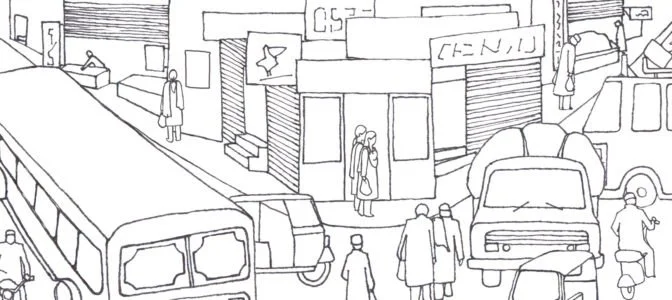THE END OF THE EMPRESS
Illustration by Anne le Guern
Gentrifiers bulldozed Karachi's iconic market years ago, but the violence unleashed in that moment never stopped.
BEFORE IT BECAME a bazaar, the land beneath Empress Market was, briefly, an execution ground. In 1857, during the War of Independence, local soldiers rebelling against colonial rule were blasted from cannons or hanged in public view, their remains sliced and sunk in a nearby drain. Karachi was the size of a small town at the time, home mostly to soldiers and fishermen, but for years after the executions, people would strew rose petals on the site, in memory of the spilled blood of their countrymen. In the mid-1880s, the British built a market for themselves on the grounds, a grand structure in the Indo-Gothic style: vaulted roofs, cusped arches, a 140-foot high clocktower studded with leopard heads. Ever since, Empress Market, christened after Queen Victoria, has presided over the toot and rattle of Karachi, watching it swell from a harbor settlement of 85,000 to a metropolis of at least 16 million people.
Tajdaar Khan’s first memories of Empress Market are from when he was so little, he didn’t need to wear pants. He would accompany his father to their shop — Sardar Khan & Sons, in Garden No. 4 of the market — and watch him sew shoes. At the time, they lived close enough, in a makeshift room above a nearby tea house, for Tajdaar to totter over, bare-bottomed, holding his father’s hand. When he was in eighth grade, his father developed hemorrhoids and his health began to fail. Tajdaar — whose name means emperor, crown-wearer — remembers pointing, innocently, to a blood stain on his father’s shalwar. He remembers, too, his father’s subsequent embarrassment and shame. Soon after, Tajdaar dropped out of school and took over the business.
He was good at it. He specialized in Peshawari chappal, a traditional Pashtun sandal: two bisecting straps of leather affixed to a sole made from truck tires. Tajdaar had lived in Karachi all his life, but his family came from Kohat, a city in northwestern Pakistan. Kohat made a muddled cameo in the eighth and final season of Homeland, Showtime’s sand-tinted war-on-terror fever dream, but other than that, people outside the country have no particular reason to know it. They may know Peshawari chappal, however: In 2014, British designer Sir Paul Smith released a similar shoe, priced at £300 and called, inexplicably, “the Robert.” A couple of years ago, Christian Louboutin trotted one out too, with its trademark red sole. On each occasion, Pakistani Twitter howled in indignation.
Tajdaar, who thinks he is 57 years old but speaks tremulously, like a much older man, didn’t know any of this and even if he had, probably wouldn’t have been too bothered. His business was steady. He sold his sandals for about 12 dollars apiece; they were worn by State Bank employees and staff at the Sind Club, a fuggy British-era institution where elite uncles puffed cigars and traded political gossip. When Pakistan won independence in 1947, Karachi swelled with migrants: some colonial remnants, such as the Sind Club, remained cloistered and under private control while others, like Empress Market, which became the property of the new state, swelled in tandem.
The market’s sprawl mimicked the city’s sprawl: manic, precarious, largely informal, with connections extending far beyond Karachi. Initially designed to accommodate 280 shops and stalls, it soon burst its seams, spilling from the inner courtyard and the wings of the market building into outer gardens, then beyond. Sardar Khan & Sons opened in 1954. The shops selling tea, birds, and nuts emerged in 1962. In the early 1970s, cloth markets appeared. Over the years, these shops assumed semi-formal status: in lieu of rent, their owners paid a regular challaan, or penalty, to the municipality. From above, the canopies of the shops looked like pieces of a jigsaw puzzle no one could quite piece together.
Not everyone was pleased with the transformation of Empress Market from an elite enclave to a working-class bazaar. In the nineties, one writer, nostalgic for the days of trams and teashops and ladies in skirts twirling parasols on public streets, described it as “a well-born governess who, through some quirk of unfortunate circumstance, has been forced to take up employment.” Other 19th-century buildings in Karachi’s colonial downtown were surreptitiously hollowed out by high-rise developers, over conservationists’ futile protests; when only their shells were left, the conservationists quieted, and apartment buildings rose from their ruins. But Empress Market was different. With its stately edifice, its elite past, and its future upmarket potential, city officials had realized that heritage and commerce didn’t have to clash. The building just had to be restored, they kept repeating like a mantra, to its former glory.
And then, the bulldozers rolled in.
Early on a Sunday morning, Tajdaar’s ringing cellphone woke him. It was the hawker next door. “You have to come now,” he said. “They’re destroying everything.”
